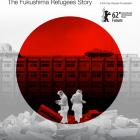Funahashi, Atsushi. Nuclear Nation. Japan: coop99, Wide House, 2013. HDCam, 145 min. https://youtu.be/NRPlbTczGAQ.
Since the 1960s, the people of Futaba had been promised prosperity with tax breaks and major subsidies to compensate for the presence of the Fukushima Daiichi Nuclear Power Plant. The day after the magnitude 9.0 earthquake on March 11, 2011, Futaba locals heard the hydrogen explosion at Reactor Number 1 and were showered with nuclear fallout. In response, the Japanese government designated the whole town as an “exclusion zone” and 1,400 of the town’s residents fled to an abandoned high school 250 kilometers away. The entire community, including the Town Hall office, was moved into the four-story building, making the residents nuclear refugees. The film portrays the evacuees as the nuclear disaster situation changes over time. One of them is Ichiro Nakai, a farmer who lost his wife, his home, and his rice fields in the massive tsunami. Doing his best to cope with the monotony of life at the evacuation center, he struggles to wipe away the haunting memories and start a new life with his son. The two finally get an official permit to enter the exclusion zone to visit their hometown. There, they see that their worst fears have become reality. The other is Katsutaka Idogawa, Futaba’s mayor, a former active supporter of the government’s nuclear policy, who was lobbying to build two additional reactors. After realizing his constituents were exposed to significant amounts of radiation and that the situation at the TEPCO plant is still unstable, his beliefs begin to change. Through the agonies and frustrations of the town’s people, the film questions the real cost of capitalism and nuclear energy. (Source: Official Film Website)
© 2013 coop99, Wide House. Trailer used with permission.
- Caldicott, Helen, ed. Crisis Without End. The Medical and Ecological Consequences of the Fukushima Nuclear Catastrophe. New York: The New Press, 2014.
- Geilhorn, Barbara and Kristina Iwata-Weickgenannt. Fukushima and the Arts: Negotiating Nuclear Disaster. Oxford: Routledge, 2017.
- Kersten, Jens, Markus Vogt, and Frank Uekoetter eds. "Europe after Fukushima: German Perspectives on the Future of Nuclear Power." Special issue, RCC Perspectives 1 (2012).
- Lochbaum, David, Edwin Lyman, Susan Q. Stranahan, and The Union of Concerned Scientists. Fukushima: The Story of a Nuclear Disaster. New York: The New Press, 2014.
- Murayama, Takehiko. "Social Impacts Induced by Radiation Risk in Fukushima." 32nd Annual Meeting of the International Association for Impact Assessment (2012).
- Siegrist, Michael, and Vivianne Visschers. "How a Nuclear Power Plant Accident Influences Acceptance of Nuclear Power: Results of a Longitudinal Study Before and After the Fukushima Disaster." Risk Analysis 33, no. 2 (2013): 333–47.
- The Independent Investigation Commission on the Fukushima Nuclear Accident, ed. The Fukushima Daiichi Nuclear Power Station Disaster: Investigating the Myth and Reality. London: Routledge Chapman & Hall, 2014.


